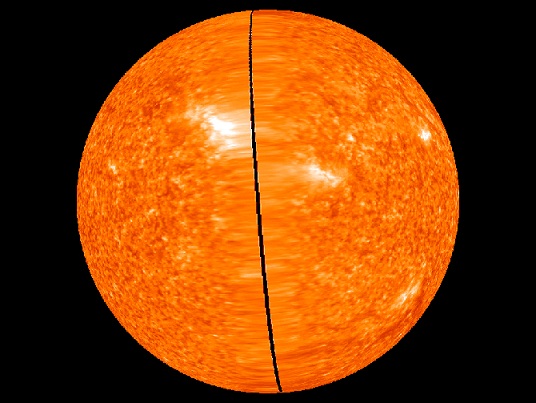The pair of spacecraft stabilized at an angle of 180 degrees from each other. From now on it will be possible to see the entire far side of the sun, including spots that may threaten the earth as the sun rotates around its axis

On February 6, a pair of NASA's stereo spacecraft orbiting the Sun moved one in an orbit slightly shorter than Earth's and the other in a more distant orbit, so that they settled into a position that allows them to see the entire Sun in front and behind.
For the first time ever, we will be able to view every solar eclipse in XNUMXD, says Angelos Varlidas, a member of the STEREO science team at the Naval Laboratory in Washington.
The solar sphere was observed by Stereo and the Soho spacecraft on January 31, 2011. Because the separation of two Stereo spacecraft was less than 180 degrees at the same time, a narrow space formed on the far side of the Sun that interfered with the 360-degree mirror simulation. The gap and the quality of the images from the far side will improve even more in the coming days and weeks.
"This is a big moment in solar physics," Worlidas said. Stirao revealed the sun as it really is - a ball of hot plasma and extremely strong magnetic fields." Each spacecraft photographs half of the star and transmits the images to Earth. The researchers combine the two points of view and form a sphere. These are not ordinary pictures. Stereo spacecraft telescopes are tuned to four wavelengths of ultraviolet radiation chosen to track features such as flares, tsunamis and magnetic storms. Nothing escapes their notice.
In the past, active sunspots would appear on the far side of the Sun suddenly, when they were hidden from Earth. The rotation of the sun could then direct this area towards Earth and spit out flames and plasma clouds with very little warning.
Not anymore, says Bill Mortoff, senior forecaster at NOAA's Space Weather Center in Boulder, Colorado. "Areas on the far side won't surprise us. Thanks to the stereo, we know they're coming."
NOAA already uses XNUMXD models fed with data transmitted by stereo spacecraft to predict the state of solar radiation for airlines, utilities, satellite operators and other customers. A complete view of the Sun will improve this forecast even further.

7 תגובות
To Cyclone: Thank you. This is also what I assume, but it is still an incorrect use of the concept of XNUMXD viewing (although it is possible to create a true XNUMXD viewing using additional photography, from Earth, simultaneously with the spacecraft.
To my father: Thank you for posting the news.
http://www.youtube.com/watch?v=B9iDVZ4fLqY&feature=channel
A better video than the one that appears on the NASA website that explains the innovation, paradoxically I got to it through the UFO category!!
Thanks. This is another one of the many glitches resulting from the site's recovery after the attack last week.
Please report any malfunctions to us
For the site administrators, there is a problem that you do not see the site title in Firefox, so you cannot return to the main page by clicking on the site logo.
The answer is on the NASA website where there is a video showing the sun rotating and thus within 5 seconds you see the entire circumference of the sun!
Yossi Yaari asked to upload the following comment
"For the first time since forever we will be able to watch every eclipse of the sun in XNUMXD". What is meant here by "in three dimensions"? In order to be able to view in XNUMXD, it is necessary to photograph the same area from two different angles (will enable stereoscopic vision).
Here, despite the name of the project, it is a simultaneous photograph of two different halves of the sun. Apparently a stereoscopic photograph, but not one that allows three-dimensional viewing.
If so, what did the poet mean?